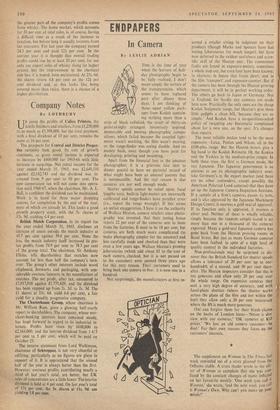ENDPAPERS
In Camera
By LESLIE ADRIAN Apart from the financial loss to the arhateur photographer, it is a grievous loss (not to dinner guests) to have no pictorial record of What might have been an unusual journey that is unrepeatable. And the real reason is that cameras are not well enough made.
Shutter speeds cannot be relied upon, focal .lengths vary, built-in light-meters are incorrectly calibrated and range-finders have parallax error (i.e., report the range wrongly). If this seems an unfair exaggeration, I have it on the authority of Wallace Heaton, camera retailers since photo- graphy was invented, that their testing house rejects 22 per cent of the cameras sent to them from the factories. It used to be 18 per cent, but cameras are both much more complicated (to make photography simpler for the amateur) and less carefully made and checked than they were even a few years ago. Wallace Heaton's proving laboratories (which add about £1 to the cost of each camera , checked, but it is not passed on to the customer) were opened three years ago for this very reason. Their customers used to bring back one camera in five: it is now one in a hundred.
Not surprisingly, the manufacturers at first re-
seined a retailer sitting in judgment on their products (though Marks and Spencer have had testing laboratories for much longer), but have now deferred to the evident usefulness and scien- tific skill of the Heaton unit. The commonest faults are found in exposure-meters, sometimes a whole stop out, but even four have been known; in shutters; in lenses that focus short; and in the film 'transport' and exposure-counter. But if the camera has been through the Heaton proving department, it will be in perfect working order. The others go back to Japan or Germany. Not to England, for hardly any cameras are made here now. Practically the only ones are the cheap Kodak Instamatic range, but Heaton's give these little gadgets a clean bill, 'because they are so simple.' And Kodak have a no-questions-asked policy of swapping any Instamatic complained about for a new one, on the spot. It's cheaper than repairs.
The most reliable makes tend to be the most expensive--Leica, Pentax and Nikon, all in the £100-plus range. But the Heaton testers give a big hand to the Kodak Retinette 18, the Konica and the Yashica in the medium-price ranges. In both these trios, the first is German made, the rest Japanese. The Japanese government is so anxious to see its photographic industry over- take Germany's in the export market (and there are no other contenders, except possibly the American Polaroid Land cameras) that they have set up the Japanese Camera.Inspection Institute. If- a sample of a firm's cameras passes its tests, and is also approved by the Japanese Machinery Design Centre, it receives a gold seal of approval. If its function only is approved, it receives a silver seal. Neither of these is wholly reliable, simply because the random sample tested is no more than one in a thousand of the cameras exported. Many a gold-seal Japanese camera has gone back from the Heaton proving rooms in Bond Street. But just as many German cameras have been faulted, in spite of a high level of quality control in the individual factories.
Non-professionals may be surprised to dis- cover that the British Standard for shutter speeds allows a tolerance of 20 per cent up to one- hundredth of a second, and 30 per cent there- after. The Heaton inspectors consider that this is too generous and allow only 20 per cent over the whole range. On expensive cameras they seek a very high degree of accuracy, and with focal-plane shutters (where the shutter works across the plane of the film and not within the lens) they allow only a 20 per cent inaccuracy where the BS is much more generous.
One can forgive them for their brash claims on the backs of London buses—'Never a dim view with our cameras,' OK cameras at KO prices,' We lost an old camera customer--he died.' For their own reasons they focus on the customers' interests.
The supplement on Woman in The Thnes last week reminded me of a story gleaned from the Odhams stable. A cross reader wrote to the cdt" tor of Woman to complain that she was con- fused by the constant changes of name inflictcd. on her favourite weekly. 'One week you call It Woman,' she wrote, 'and the next week you call it Woman's Own. Why can't you make up your minds?'


































 Previous page
Previous page